|
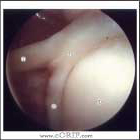
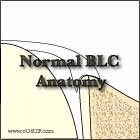
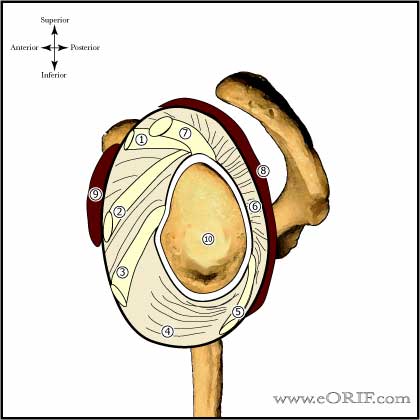
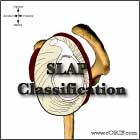

 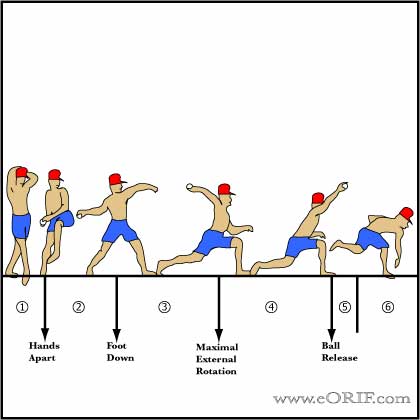
|
synonyms: SLAP lesion, SLAP tear, superior labral anterior posteior tear, biceps anchor tear
SLAP ICD-10
A- initial encounter
D- subsequent encounter
S- sequela
SLAP ICD-9
- 840.7 = Superior glenoid labrum lesion.
SLAP Etiology / Epidemiology / Natural History
- Acquired Posterior Capsular Contracture in throwing athletes leads to high torsional and shear stress on the posterosuperior labral in the late-cocking phase of throwing, which can produce a posterior SLAP lesion. Throwers may feel sharp pain in the extreme abduction/ER position followed by "dead arm" sensation and loss of throwing velocity.
- History of falls directly on shoulder, downward force on outstretched arm, or sudden eccentric force on a contracting biceps.
SLAP Anatomy
- The normal superior sublabral sulcus can be up to 4-5mm deep and must be differentiated arthroscopically from a Type II SLAP lesion which should be >5mm and have a gap between the articular cartilage and the labral attachment.
- Blood supply: the labrum receives its blood supply from the suparscapular artery, circumflex scapular branch of the subscapular artery, and the posterior circumflex humeral artery. The anterior/superior labrum has the least vascularity of the glenoid labrum.
- See also Shoulder Anatomy
SLAP Clinical Evaluation
- Vague discomfort, sliding with overhead use. May have painful clicking or popping sensation with shoulder motion, especially overhead activity.
- Throwing athletes report deep shoulder pain in the late cocking position and loss of velocity.
- Speed’s Test= pain in anterior shoulder / bicipital groove as the shoulder is flexed against resistence to 90 degrees of flexion with forearm suppinated .
- SLAP test=unstable type II and IV superior labral lesions. Arm held in 90 abduction with hand fully suppinated. Examiner places one hand on shoulder with thumb in 6 o’clock position in axilla. Opposite hand exerts downward force on outstretched hand creating a fulcrum with thumb shifting humeral head superiorly. Crepitation, buckling, pain = positive test.
- O’Brien Test: arm in forward flexion to 90 degrees, adduction @10 degrees, and IR(thumb down). Examiner pushes down on forearm with patient resisting. Positive test is pain that is alleviated with ER(palm up). Superficial/anterior pain=AC joint. Deep/posterior pain=labral tear/SLAP. (O’Brien SJ, AM J Sports Med 1998;26;610-613).
- Anterior Slide Test: Patient standing the hands on the hips with the thumbs pointing posteriorly. Examiner stabizes scapula with one hand on the acromion while the other hand applies force to the elbow attempting to drive the humeral head anterosuperiorly with the patient resisting the force. Pain, popping, or clicking in the front of the shoulder indicates SLAP tear.
- Relocation Test= posterosuperior shoulder pain (not apprehension) when should is abducted and ER. Pain is releaved with posteriorly directed force on proximal humerus. Must be differentiated from apprehension/relief from anterior instability.
- Fulcrum test(load and shift)-thumb used to exert a force in the direction of area tested causes pain. (12o’clock=SLAP tears, 1o’clock=superior GH ligament injury, 3 o’clock=middle GH ligament tears etc)
- Assess for GIRD.
- May have mild impingement signs do to secondary RC irritation
SLAP Xray / Diagnositc Tests
- AP, scapular lateral and axillary views generally normal.
- MRI arthrogram (gadolinium). Lesion is best seen on oblique coronal images. Contrast is seen extending, with an irregular pattern, into the normally dark triangle of the superior labrum (Bencardino JT, Radiology 2000;214:267). Type III and type IV lesions may show a labral fragment dangling from the superior labrum. 51% of the arthroscopicaly confirmed SLAP lesions are correctly diagnosed by community radiologists up to 69% for musculoskeletal radiologists. (Reuss BL, JSES 2006;15:580).
- Diagnostic arthroscopy provides definitive diagnosis.
SLAP Classification / Treatment (Classification = Snyder SJ, Arthroscopy 1990;6:274)
- Intial Treatment: 3 months of physical therapy focusing on strengthening the dynamic stabilizers. If non-op treatment fails to eliminate symptoms surgical treatment determined by SLAP lesion classification is indicated.
- Type I= degenerative superior labrum with fraying along the free margin. Treatment = debridement
- Type II = superior labrum detached from the glenoid medially, leaving the superior glenoid neck uncovered for at least 5mm from the corner of the glenoid. There is a gap between the articular cartilage and the labral attachment to bone. Can be further subdivided into (A)anterior, (B)posterior, and (C)combined anterior-posterior lesions. Treatment = arthroscopic SLAP Repair: consider Biceps Tenodesis in low demand patients >40 years old. SLAP repair vs Tenodesis: Similar postoperative scores; return to sports 20% to 95% for SLAP repair and 73% to 100% for BT. Reoperation rates are 2.9% to 40% for SLAP repair and 0% to 15.3% for BT. (De Sa D, Arthroscopy 2019 DOI: https://doi.org/10.1016/j.arthro.2018.12.015)
- Type III = Bucket-handle tear of the superior labrum. Treatment = biceps tenotomy with or without Biceps Tenodesis.
- Type IV = Bucket-handle superior labral tear that extends into the biceps tendon. Treatment = biceps tenotomy with of without Biceps Tenodesis.
- Any associated GIRD should be treated with posterior capsular release.
SLAP Associated Injuries / Differential Diagnosis
SLAP Complications
- Recurrence / failure, Hardware failure / Anchor pull-out, Infections, Stiffness, CRPS, Nerve injury: Axillary nerve, Brachial plexus, Fluid Extravasation:, Chondrolysis, Hematoma, Chondral Injury / arthritis. Medical and anesthesia risks of surgery include heart attack, stroke and death.
- Recurrence / failure
- Hardware failure / Anchor pull-out
- Infections
- Stiffness
- CRPS
- Nerve injury: Axillary nerve, Brachial plexus
- Fluid Extravasation:
- Chondrolysis: though to be related to heat from electo cautery or radiofrequency probes used during capsular release or capsular shrinkage.
- Hematoma
- Chondral Injury / arthritis
- Instrument failure
SLAP Follow-up Care
- Post-Op: Place in sling. Active wrist, hand ROM. Pendelum shoulder exercises. Avoid any active elbow flexion/supination. Keep elbow flexed and humerus internally rotated to avoid tension on biceps.
- 10 days: Start PT, continue sling for 4 weeks. Avoid any active elbow flexion/supination. Avoid excessive external rotation, especially in abduction to limit shear forces on the repair.
- 6 weeks: Discontinue sling. Progressive strenghening program.
- 3-6 months: Sport-specific rehabilitation.
- 6 months: Return to sport / unrestricted activity
- SLAP Rehab protocol.
- Thrower's Ten Exercise Program
- SLAP repair results: 75% return to preinjury competition / function (Ida J, AJSM 2005;33:507).
- Outcome measures: ASES score, pain scales.
SLAP Review References
- Burkhart SS, A Cowboy's Guide to Advanced Shoulder Arthroscopy, 2006
- Maffet MW, in Delee and Drez Orthopedic Sports Medicine, 2nd ed, 2003
- OKU - Shoulder and Elbow 2nd ed, 2002
- Snyder SJ, Arthroscopy 1990;6:274
- Burkhart SS, Morgan CD. The peel-back mechanism: Its role in producing and extending posteior Type II SLAP lesions and its effect on SLAP repair rehabilitation. Arthroscopy 1998;14:637-640.
- Snyder SJ, Banas MP, Karzel RP. An analysis of 140 injuries to the superior glenoid labrum. J Shoulder Elbow Surg 1995;4:243-248)
|







